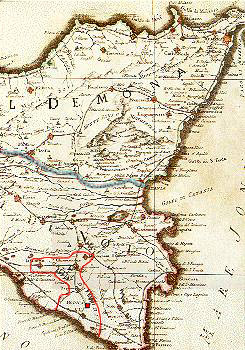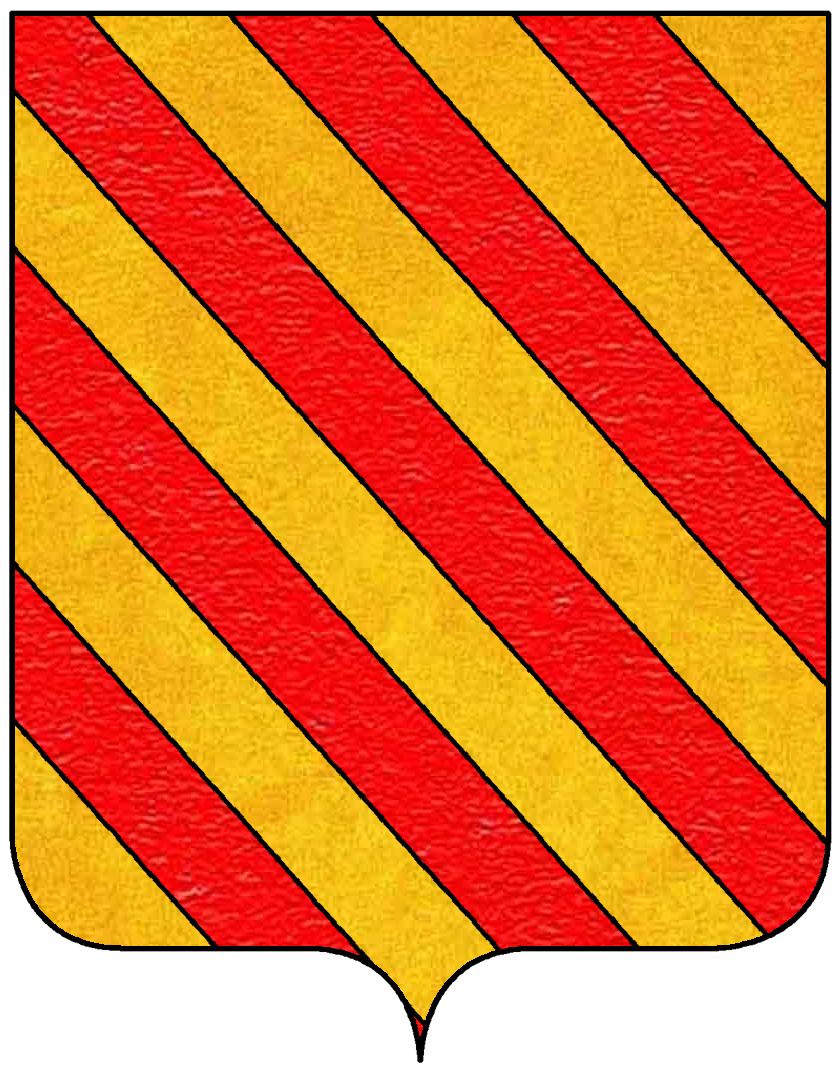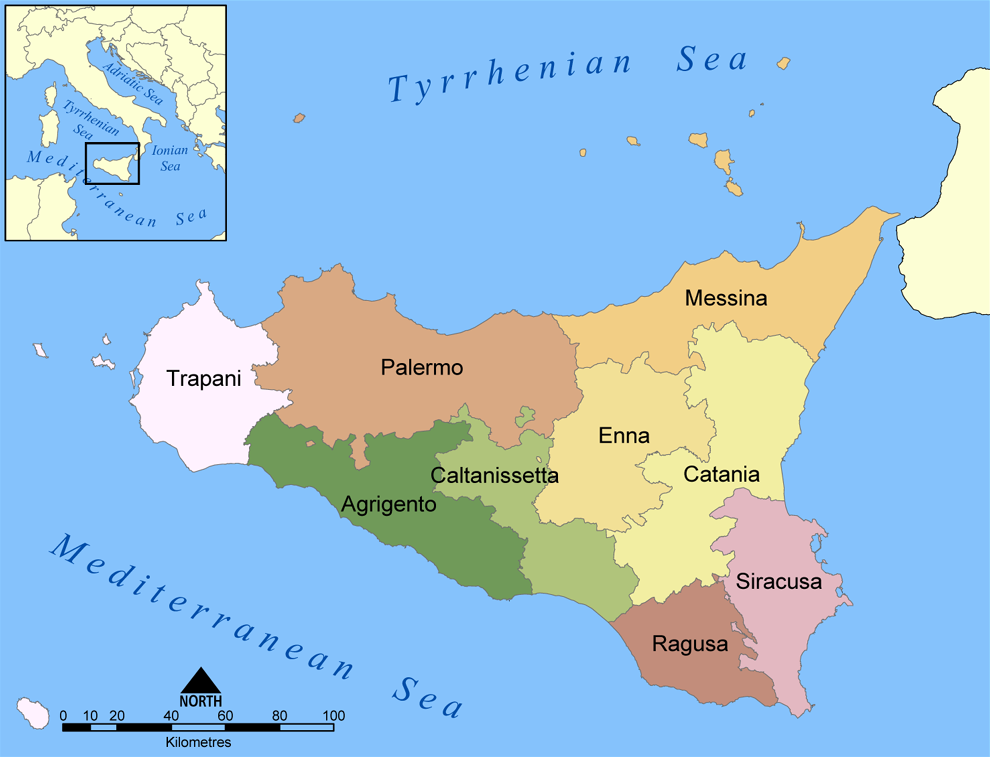|
Chiaramonte
The Chiaramonte are a noble family of Sicily. They became the most powerful and wealthy family in Sicily. In the 13th century the marriage of Manfredi Chiaramonte to Isabella Mosca, united the two Sicilian counties of Modica and Ragusa. Around 1307–1320, the couple built the family seat, the Palazzo Chiaramonte, in Palermo. The family's great power in Sicily lasted until 1392 with the execution of Andrea Chiaramonte, 8th Count of Modica, last defender of Palermo for King Frederick IV of Sicily against the illegitimate pretender Martin I of Aragon. It was outside of the Palazzo Chiaramonte that Andrea Chiaramonte was executed on 1 June 1392 Following the fall of the House of Chiaramonte, their palace became known as the Palazzo Steri. The palazzi subsequently became the residence of Martin I of Aragon and of Blanche de Navarre, then the Spanish viceroys, and then a prison of the Inquisition. Today, the palace's much copied and distinctive form of Norman Gothic archit ... [...More Info...] [...Related Items...] OR: [Wikipedia] [Google] [Baidu] |
County Of Modica
The County of Modica was a feudal territory within the Kingdom of Sicily from 1296 to 1812. Its capital was Modica, on the southern tip of the island, although the cities of Ragusa and Scicli housed some government offices for a period. Today it perpetuates as a title only held by the head of the House of Alba, Carlos Fitz-James Stuart, 19th Duke of Alba. History The Chiaramontes On 25 March 1296, the Aragonese King Frederick III of Sicily conceded the great County of Modica to Manfredi I Chiaramonte, who fought the Angevin and their king, Charles, and married Isabella Mosca, daughter of the rebel count Federico Mosca. The king gave the first dynasty of counts many fiefdoms in Agrigento, Caccamo, Licata and Palermo, where they built the Palazzo Chiaramonte, also known as Palazzo Steri; once the residence of the Aragonese-Spanish viceroys of Sicily and later the tribunal of the Inquisition, it now belongs to the University of Palermo. On its ceilings is one of the most i ... [...More Info...] [...Related Items...] OR: [Wikipedia] [Google] [Baidu] |
Chiaramonte Gulfi
Chiaramonte Gulfi (Sicilian language, Sicilian: ''Ciaramunti'') is a town and ''comune'' in the province of Ragusa, Sicily, southern Italy. Geography Chiaramonte Gulfi is located on a hill-top north of Ragusa, Italy, Ragusa at an altitude of Above mean sea level, above sea level. The highest point is on Monte Arcibessi at . Its hamlets (Frazione, ''frazioni'') are the villages of Piano dell'Acqua, Roccazzo and Sperlinga. The town is also called ''Balcony of Sicily'' for its panoramic position, with views over the ''Valley of the Ippari'' and its towns (Comiso, Vittoria, Sicily, Vittoria, Acate) and all the way to the Mediterranean Sea if looking south, as far as Mount Etna in direction north and to the Erean Mountains with Caltagirone if looking west. History In the area numerous archeological sites from the Bronze Age and Iron Age have been found, as well as ruins dating to the Greeks, Greek Archaic era and Hellenistic Greece, Hellenistic era. Also Ancient Rome, Roman, Byza ... [...More Info...] [...Related Items...] OR: [Wikipedia] [Google] [Baidu] |
Andrea Chiaramonte
Andrea Chiaramonte (???? – 1 June 1392) was a representative of the Sicilian nobility in the 14th century. Andrea Chiaramonte was given the County of Modica, which included the municipalities of Modica, Ragusa, Scicli, Pozzallo, Ispica, Chiaramonte Gulfi, Comiso, Giarratana, Monterosso Almo. He was the lord of Caccamo, Castronovo, of the castle of Palma di Montechiaro, and of the castle of Mussomeli. He also inherited the title of Count of Malta and Gozo from his father Manfredi Chiaramonte. He established his court at the Palazzo Steri in Palermo. Andrea succeeded Manfredi as the seventh count of Modica, and continued the policy of aversion to the Aragonese of Sicily. When Martin I became king of Sicily following his marriage to Maria di Sicilia, he then reconquered the island militarily, the Chiaramontes found themselves together with the Alagonas alone to face the Catalan army of Bernat (or Bernardo) Cabrera. Andrea, defeated and betrayed, was captured on May 17 al ... [...More Info...] [...Related Items...] OR: [Wikipedia] [Google] [Baidu] |
Manfredi Chiaramonte
Manfredi III Chiaramonte (died November 1391) was a Sicilian nobleman. Of French origins, he was given the County of Modica, then one of the most powerful fiefs in the Kingdom of Sicily, in 1377. He was also made lord of Trapani, Agrigento, Bivona, Licata, Castronovo, Lentini, Palma di Montechiaro and Mussomeli, where he built a castle which still bears his name. Manfredi was governor of Messina and, after having liberated the island of Jerba from Arab pirates, he was made also lord of it. He held court in the Palazzo Chiaramonte of Palermo. Despite having obtained his lands by the Aragonese Kings of Sicily, he usually sided for the Angevines who held the rival Kingdom of Naples. In 1354 Manfredi was besieged in Lentini by the Aragonese troops of Artale I Alagona; the latter was able to capture it by treason only in 1360. Manfredi was captured and imprisoned in Catania; however he later escaped and regained his possessions. His daughter Costanza (born 1377) married the ... [...More Info...] [...Related Items...] OR: [Wikipedia] [Google] [Baidu] |
Palazzo Chiaramonte
Palazzo Chiaramonte-Steri is a Gothic-style palace located on via Piazza Marina, facing the Giardino Garibaldi in the ancient quarter of Kalsa of Palermo, region of Sicily, Italy. History The building, intended to be the family palace or castle, was begun as by 1320 under the patronage of the powerful Sicilian lord Manfredi III Chiaramonte. He commissioned the decoration of the ''Sala Magna'' ("Grand Hall"), with a painted wooden ceiling by Cecco di Naro, Simone da Corleone and Pellegrino Darena. From the late 15th century to 1517 it housed the Aragonese-Spanish viceroys of Sicily; later it was home to the Royal Customs and, from 1600 to 1782, the tribunal of the Holy Inquisition. The ground floor is mainly a rusticated stone wall, while the second story, piano nobile, is graced with mullioned windows. The tower's roofline is merlionated. The palace was restored in the 20th century, with numerous elements associated with its role as a jail of the Inquisition. During the works ... [...More Info...] [...Related Items...] OR: [Wikipedia] [Google] [Baidu] |
The Del Carreto Barons Of Racalmuto
del Carreto, Baron of Racalmuto were the descendants of Constanzia di Chiaramonte (1290–1350) the heiress and daughter of Federico di Chiaramonte, Lord of Racalmuto a member of the prominent Sicilian Chiaramonte family. Constanzia married Antonio del Carretto on 11 November 1307. This marriage unified the del Caretto and Chiaramonte families bringing to the family the ancient Racalmuto titles. For the following two centuries the del Carretto and Racalmuto names were united. Constanzia died at Girgenti in 1350. References Sicilian noble families it:Del Carretto {{italy-stub ... [...More Info...] [...Related Items...] OR: [Wikipedia] [Google] [Baidu] |
Ragusa, Italy
Ragusa (; scn, Rausa ; la, Ragusia) is a city and ''comune'' in southern Italy. It is the capital of the province of Ragusa, on the island of Sicily, with 73,288 inhabitants in 2016. It is built on a wide limestone hill between two deep valleys, Cava San Leonardo and Cava Santa Domenica. Together with seven other cities in the Val di Noto, it is part of a UNESCO World Heritage Site. History The origins of Ragusa can be traced back to the 2nd millennium BC, when there were several Sicel settlements in the area. The current district of Ragusa Ibla has been identified as Hybla Heraea. The ancient city, located on a hill, came into contact with nearby Greek colonies, and grew thanks to the nearby port of Camerina. After a short period of Carthaginian rule, it fell into the hands of the ancient Romans and the Byzantines, who fortified the city and built a large castle. Ragusa was occupied by the Arabs in 848 AD and remained under their rule until the 11th century, when ... [...More Info...] [...Related Items...] OR: [Wikipedia] [Google] [Baidu] |
Palma Di Montechiaro
Palma di Montechiaro ( scn, Parma di Muntichiaru) is a town and '' comune'' in the province of Agrigento, Sicily, southern Italy. Many Greek archaeological findings have been found near the town. Formerly known as Palma, in 1863, Montechiaro was added to the name, in honour of the Chiaramonte family whose stronghold is close to the town. Controversy In 2002, ''La Repubblica'' reported the presence of the prominent Italian politician Angelino Alfano (a Silvio Berlusconi protégé) at the 1996 wedding of the daughter of Croce Napoli (died 2001), believed by investigators to be the Mafia boss of Palma di Montechiaro, as shown on an amateur video of the party. Alfano, then a deputy of the Sicilian Regional Assembly, was greeted with affection by Croce Napoli. Alfano at first told ''La Repubblica'' he had "no memory or recollection of this wedding" and that "I never participated in a wedding of Mafia or of their children, I do not know his wife, Gabriella, and I've never heard of M ... [...More Info...] [...Related Items...] OR: [Wikipedia] [Google] [Baidu] |
Province Of Ragusa
The Province of Ragusa ( it, Provincia di Ragusa; Sicilian: ''Pruvincia 'i Rausa'') was a province in the autonomous region of Sicily in southern Italy, located in the south-east of the island. Following the abolition of the Sicilian provinces, it was replaced in 2015 by the Free municipal consortium of Ragusa. Its capital is the city of Ragusa, which is the most southerly provincial capital in Italy. Geography From Scoglitti to Pozzallo, the Ragusan coastline is approximately long. Along the Ragusan coast are many fishing villages such as Kaukana, Punta Secca, Marina di Ragusa and Marina di Modica. The Hyblaean Mountains are dominating the north of the province and its highest peaks are Monte Lauro, Monte Casale and Monte Arcibessi. The rivers of the province are the Irminio, Dirillo and Ippari and the only lake in the province is the Lago di Santa Rosalia along the course of the Irminio river. The skyline of Ragusa is punctuated by the towers, domes and cupolas of ... [...More Info...] [...Related Items...] OR: [Wikipedia] [Google] [Baidu] |
Norman Gothic
Norman or Normans may refer to: Ethnic and cultural identity * The Normans, a people partly descended from Norse Vikings who settled in the territory of Normandy in France in the 10th and 11th centuries ** People or things connected with the Norman conquest of southern Italy in the 11th and 12th centuries ** Norman dynasty, a series of monarchs in England and Normandy ** Norman architecture, romanesque architecture in England and elsewhere ** Norman language, spoken in Normandy ** People or things connected with the French region of Normandy Arts and entertainment * ''Norman'' (film), a 2010 drama film * '' Norman: The Moderate Rise and Tragic Fall of a New York Fixer'', a 2016 film * ''Norman'' (TV series), a 1970 British sitcom starring Norman Wisdom * ''The Normans'' (TV series), a documentary * "Norman" (song), a 1962 song written by John D. Loudermilk and recorded by Sue Thompson * "Norman (He's a Rebel)", a song by Mo-dettes from ''The Story So Far'', 1980 Businesses * ... [...More Info...] [...Related Items...] OR: [Wikipedia] [Google] [Baidu] |
Province Of Agrigento
The Province of Agrigento ( it, Provincia di Agrigento; scn, Pruvincia di Girgenti; officially ''Libero consorzio comunale di Agrigento'') is a province in the autonomous island region of Sicily in Italy, situated on its south-western coast. Following the suppression of the Sicilian provinces, it was replaced in 2015 by the Free municipal consortium of Agrigento. It has an area of , and a total population of 474,493. There are 43 comunes ( it, link=no, comuni) in the province. History and location It is surrounded by Province of Palermo in the north, Trapani in the west, Mediterranean Sea in the south and Caltanissetta in the east. Gela inhabitants founded the province in 6th century B.C. as Akragas. The province was destroyed by the Carthage in 406 B.C. but was later ruled by the Romans, Goths, Byzantines and Arabs. The Arabs rebuilt several parts of the province. Several ancient Doric temples were constructed during the 6th and 5th century B.C. for the purpose of worshiping ... [...More Info...] [...Related Items...] OR: [Wikipedia] [Google] [Baidu] |





.jpg)
